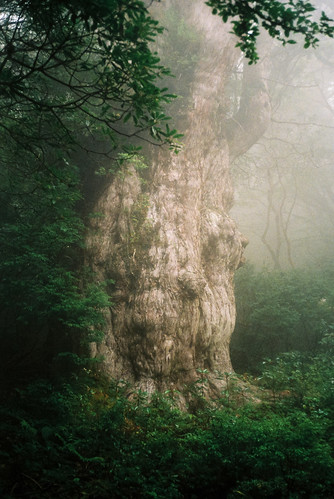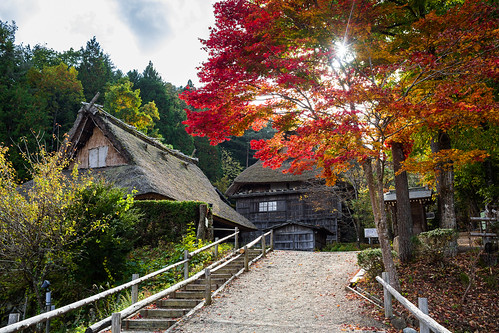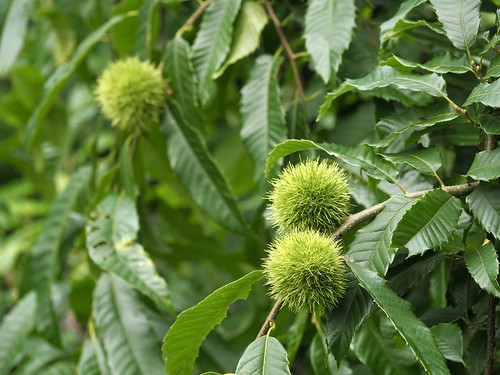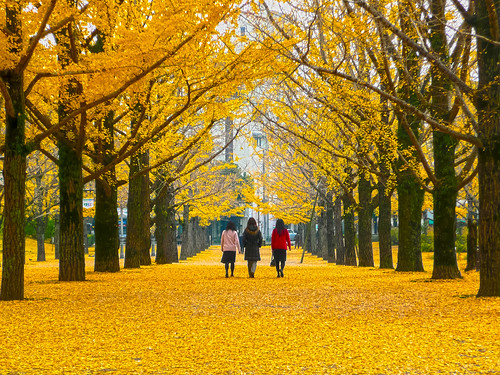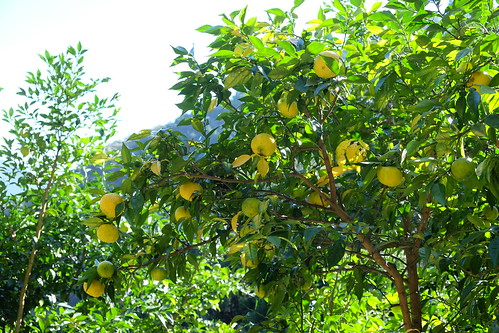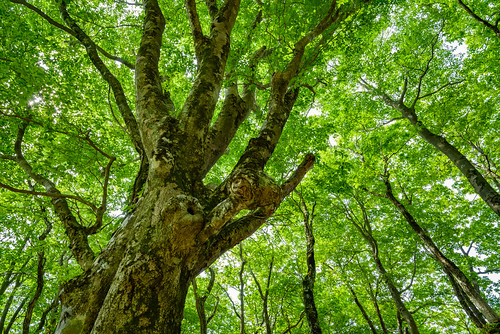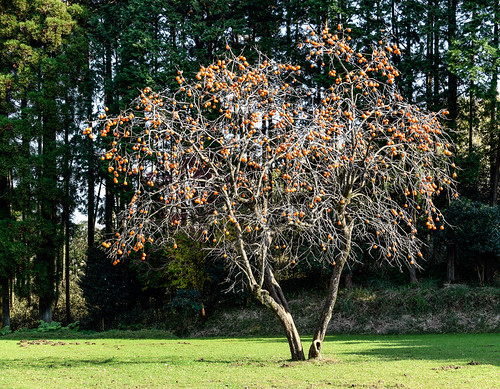When you think of the types of Japanese trees…
You may likely think of Sakura, the Cherry Blossom — which is completely understandable.
However, there are so many more types out there that are just as beautiful and iconic!
And in this guide, you’ll learn about the 14+ types of Japanese trees.
So, let’s start with the most popular type of Japanese tree…
1. Sakura (Cherry Blossom)
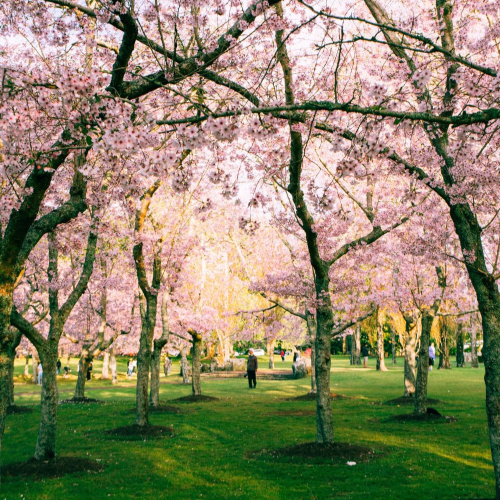
The most iconic Japanese tree is the Sakura or the Japanese cherry blossom tree.
You’ll notice them, especially along rivers and parks so that there will be beautiful pink flowers during springtime.
Every spring Japanese people gather in places with blooming cherry blossoms with friends and family.
This event is called “hanami”, and there will typically be barbecues, lunch boxes, and drinks.
(Hanami image – source – beautiful Japanese words by Linguajunkie.com)
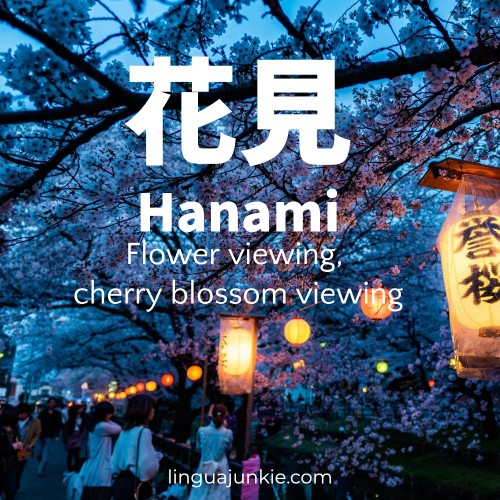
There are many different varieties of cherry blossom trees such as the “somei yoshino”, which features white-pink flowers, or the “shidare zakura”, which has cascading branches.
- Related post: Cherry Blossom Facts
2. Sugi (Japanese Cedar)
Another important Japanese tree is the Japanese cedar or Sugi.
One of the most famous Sugi trees is located on Yakushima Island and is called the Jomon Sugi.
People believe that it is over 7000 years old. In traditional Japanese construction, Sugi has been used to build temples, shrines, and tea houses.
It is also known for its unique fragrance and can be found as an incense.
3. Hinoki (Japanese Cypress)
Hinoki is another important Japanese tree due to its resistance and durability.
It is also prized for its scent which is soothing and relaxing.
(For example, you can find Hinoki incense on Amazon (click here).)
Hinoki is a popular material for baths and onsen because of its fragrance.
Hinoki oil is said to be great for those suffering from insomnia and anxiety.
4. Matsu (Japanese Pine)
Matsu is a symbolic tree in Japan, and the local people use it as a New Year decoration called “Kadomatsu”.
This welcomes ancestral spirits and different gods.
You can often see them as part of traditional Japanese gardens because of the way the trunks and branches create a sense of rugged beauty.
It is also a common tree used for bonsai since you can easily mold it into different shapes and keep it small.
5. Keyaki (Japanese Zelkova)
This tree is important for Japanese craftspeople because of its beautiful grains.
They are suited for making furniture and other wooden items.
It is one of the most expensive woods because they need to grow to be at least 70-80 years old before getting chopped down and processed into furniture.
Keyaki is also found in Japanese gardens and as a bonsai tree.
6. Momiji (Japanese Maple)
This is one of the most popular types of Japanese trees.
The Japanase maple, or “Momiji”
And the Japanese maple is popular for the brilliant colors.
In fact, going to see the autumn color leaves is a popular activity for Japanese people — it’s called momijigari.
(source – Japanese autumn words by Linguajunkie.com)
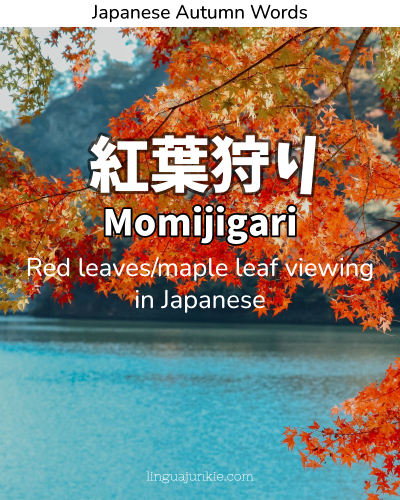
So, the Momiji tree is a big part of this fall landscape and aesthetic.
They are planted in gardens, parks, and temples across Japan so that they can be enjoyed during the fall season.
7. Kuri (Japanese Chestnut)
Kuri is an important tree for Japanese people because the Japanese love to eat chestnuts during the fall season.
Chestnuts are usually roasted or added to various sweets with red bean paste.
In some communities in Japan, they also hold harvest festivals where chestnuts are sold.
One of the most famous chestnut festivals is held in Tokyo called Kuri Matsuri.
8. Ume (Japanese Plum)
Another important tree is the Japanese plum tree.
It is prized both for its fruit and its flower.
The Ume blooms slightly earlier than the cherry blossom and can signify the end of winter and the start of spring.
Plums are also part of the Japanese food culture.
Salted plums are a popular condiment with rice and fresh plums can be turned into juice or fruity rice wine — known as umeshu.
- Related: Umeshu plum wine guide
9. Katsura (Japanese Judas Tree)
The Katsura tree is prized for its beautiful fall colors.
It is unique because the leaves turn different shades from yellow, orange, and red.
It also has a great smell that can be similar to caramel.
It is a popular tree inside parks and gardens because of its ornamental quality.
During the summer, it also provides a great amount of shade to make the summer heat more bearable.
10. Akagashi (Japanese Red Oak)
This is a hardy tree variety native to Japan.
It is known for its strength and durability in Japanese culture.
It is an evergreen tree and provides a nice green color year-round which makes it perfect for gardens and parks.
Akagashi is also an important tree because it is used to make musical instruments like shamisen.
Its durability against water also makes it ideal for boats, rudders, and paddles. T
he name Akagashi comes from the word “red” or “aka”, and it is because of the wood’s distinct reddish color.
11. Ichou (Gingko Tree)
You might notice a Gingko tree because of its strong smell during the autumn.
In Japan, it is a highly prized tree because of the nuts that fall from it.
It also features a brilliant yellow color during the autumn season.
Gingko nuts are eaten widely across Japan as a snack and as part of the cuisine.
12. Yuzu (Japanese Citrus Tree)
Yuzu is a unique Japanese fruit that grows on a citrus tree native to East Asia.
The flavor is similar but different from a lemon.
If there is a large yuzu harvest many households will add the yuzu inside of the baths for an amazing bath scent.
It is also great for flavoring dishes and desserts.
13. Buna (Japanese Beech)
This is a very common tree in Japanese forests and woods.
The trees turn a beautiful golden-yellow color during the fall.
It tends to grow very high up to 35 meters tall with many leafy branches.
It is native to Japan where you’ll find them from the north, in Hokkaido, to Kyushu, in the south of Japan.
14. Kaki (Oriental Persimmon Tree)
The persimmon fruit is popular during the winter months as it is often dried outside.
These trees are important for Japanese people so that they can also harvest their persimmons.
The fruit is extremely sweet with a bright orange color.
The leaves of the tree are glossy and green which makes it a wonderful addition to gardens.
Conclusion
Now you know about the types of Japanese trees…
Their cultural significance, if any…
Plus, when you’d be able to see them.
Which are your favorite?
Are there any missing from this list?
Leave a comment!

